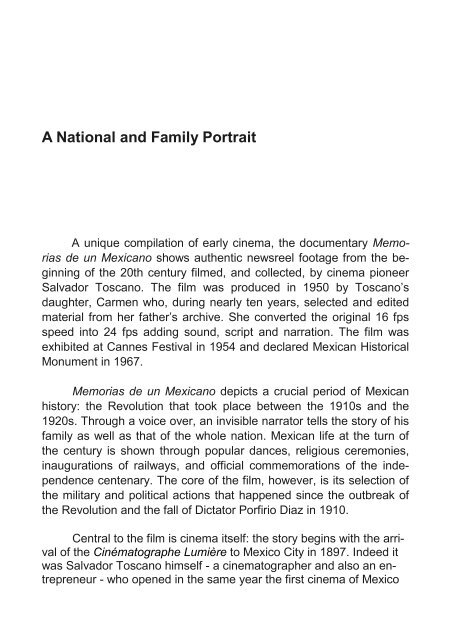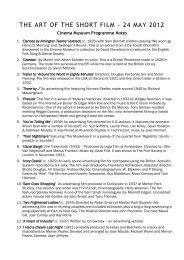"Memorias de un Mexicano" - brochure - The Cinema Museum
"Memorias de un Mexicano" - brochure - The Cinema Museum
"Memorias de un Mexicano" - brochure - The Cinema Museum
You also want an ePaper? Increase the reach of your titles
YUMPU automatically turns print PDFs into web optimized ePapers that Google loves.
A National and Family Portrait<br />
A <strong>un</strong>ique compilation of early cinema, the documentary <strong>Memorias</strong><br />
<strong>de</strong> <strong>un</strong> Mexicano shows authentic newsreel footage from the beginning<br />
of the 20th century filmed, and collected, by cinema pioneer<br />
Salvador Toscano. <strong>The</strong> film was produced in 1950 by Toscano’s<br />
daughter, Carmen who, during nearly ten years, selected and edited<br />
material from her father’s archive. She converted the original 16 fps<br />
speed into 24 fps adding so<strong>un</strong>d, script and narration. <strong>The</strong> film was<br />
exhibited at Cannes Festival in 1954 and <strong>de</strong>clared Mexican Historical<br />
Monument in 1967.<br />
<strong>Memorias</strong> <strong>de</strong> <strong>un</strong> Mexicano <strong>de</strong>picts a crucial period of Mexican<br />
history: the Revolution that took place between the 1910s and the<br />
1920s. Through a voice over, an invisible narrator tells the story of his<br />
family as well as that of the whole nation. Mexican life at the turn of<br />
the century is shown through popular dances, religious ceremonies,<br />
inaugurations of railways, and official commemorations of the in<strong>de</strong>pen<strong>de</strong>nce<br />
centenary. <strong>The</strong> core of the film, however, is its selection of<br />
the military and political actions that happened since the outbreak of<br />
the Revolution and the fall of Dictator Porfirio Diaz in 1910.<br />
Central to the film is cinema itself: the story begins with the arrival<br />
of the Cinématographe Lumière to Mexico City in 1897. In<strong>de</strong>ed it<br />
was Salvador Toscano himself - a cinematographer and also an entrepreneur<br />
- who opened in the same year the first cinema of Mexico



